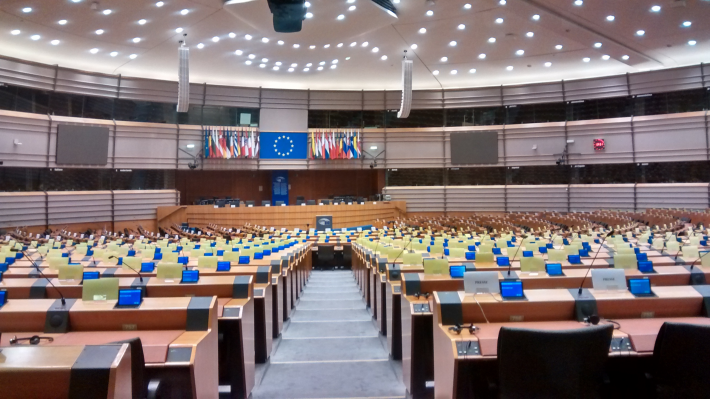Policy in the European Parliament
Sofia Cota-Franco is a Knowledge Exchange Fellow based at Newcastle University. This blog is an adaptation of a longer version of her account of shadowing Julie Girling MEP, to be published in The Bulletin, which goes the extra mile and focuses on lessons learnt on how to influence policy.

A tale of two Brussels
Brussels is an impressive city. Full of hidden pearls of mouth-watering moules-frites, authentic artisanal beers, gorgeous chocolate sculptures, and the ever so stylish Art Nouveau that begs you not to leave. But this not why I am here – my goal is clear: to absorb like a sponge all I can about the workings of this EU decision powerhouse and learn how researchers can leave their mark in policy. As I arrive I am both nervous and excited, not quite knowing what to expect. I am all questions: How does everything work? How are decisions made? Does any evidence really go into policy?
Jumping into deep water
As I get to the European Parliament and am welcomed by Julie’s staff, the immersion into the workings of the European Parliament starts. Alison, Jack and Alex are Julie’s support team in Brussels and spread themselves thin between answering to constituents’ concerns, to fulfilling the job of knowing of everything that is happening everywhere, to advising in an endless range of subjects and having the patience to go through (very boring) pieces of legislation and screen them to the nitty-gritty. Julie is highly impressive too: jumping from subject to subject, being on top of legislation, having a role in various committees, making the effort to always sit on a vote or discussion well informed and still pursuing topics she feels strongly about – a sea of demands on her time. Yet she is highly approachable and her dedication is nothing short of remarkable. This is a hard-core crowd.
I spend my first afternoon in the European Parliament at the ENVI/ITRE/AGRI/PETI joint meeting for the Public Hearing on the European Citizens’ Initiative to ban glyphosate – it could not get more controversial than this. Passions are high, evidence gets blurred with emotion, conflicting agendas pull their separate ways, in a debate bound to have no winners. It is fascinating to see how the whole process works. There is lots of information going around, some is true misinformation, some is good information being misused and some is accurate information and indisputable facts – which are framed one way or another depending on which points people wish to highlight or hide. There is a hint of chaos within this highly democratic process, and I can barely grasp how difficult it must be to have to constantly decode this information and separate reality from myths. Though it is a far from perfect system, the encouraging news is that a lot of solid evidence does seem to find its way into policy – the issue is what determines which good information arrives at the destination and squeezes into policy and which one perishes?
There is also the issue of the “all so mighty little details”. Next day, as I sat in on the ENVI committee meeting and listened to the Implementation session on food safety legislation, where the European Parliament got the chance to exchange views with European Commission representatives on the regulation on food information to consumers, I witnessed the discussion about misleading labelling. This went on to the detail of label’s font size and what can and cannot be claimed on the label of different products. I am mightily impressed and take a mental note that perhaps it was naive of me to underestimate the critical importance of such simple details and how they can so completely shift how policy can affect our day-to-day life.
On that afternoon I was lucky enough to sit through a PECH committee meeting, which discussed the sustainable and competitive European aquaculture sector – finally a topic that I could safely say I understand inside out. The amount of evidence being thrown at the floor was staggering, and so were the conclusions taken from it. I was pleasantly surprised on how knowledgeable some MEPs were on the topic, understanding the industry and its challenges, while others (a minority, to be fair) not so much. Overall the discussion was down to earth, focusing both on the livelihoods of people affected by policy decisions, but also on how to assure a sustainable use of resources and environmentally-sound practices. Different countries had conflicting priorities, and this was very evident on their stand, knowledge on the subject and commitment brought to the table. It is incredible how any decisions can be made at all in such polarised situations. Most importantly, these discussions were deep and again to the tiniest detail, as evidence was presented and fought over, back and forth.
Time to change the music
Much more could be told, from the various back-stage meetings, to Julie’s participation at the Conference of the European partnership for alternative approaches to animal testing, to a unique truly European feeling that you get as you see such diverse people come together to set the rules and build a shared vision. My journey with Julie and her team was an exciting ride and I remain humbled by the work being done at the European Parliament. If you want to know more about my experience at the EU parliament, you can email me or reach me through twitter @AquacultureKE.
It is completely worth putting the effort in trying to understand the system, so that we can work our way to making an impact. As researchers, we must get involved, build our message, understand its practical implications, and make our way into communicating this to the world. It is worth putting the science out there. It is time to change the music.
Like what we stand for?
Support our mission and help develop the next generation of ecologists by donating to the British Ecological Society.